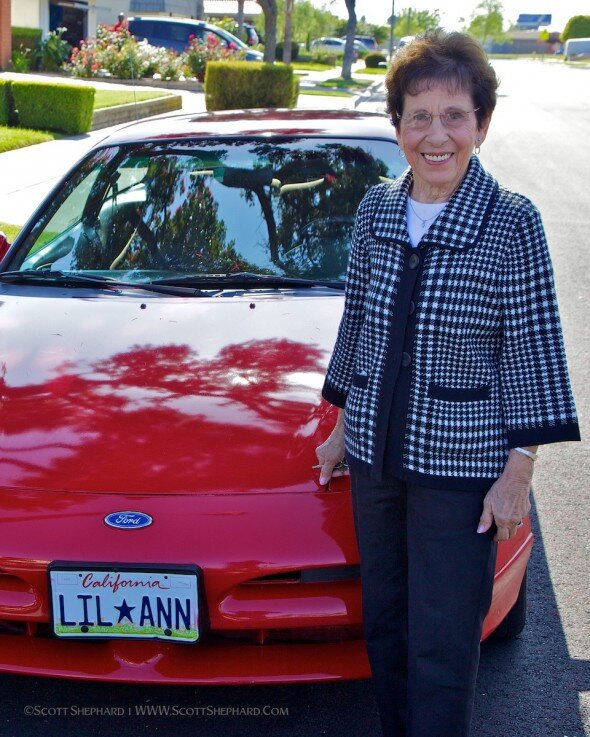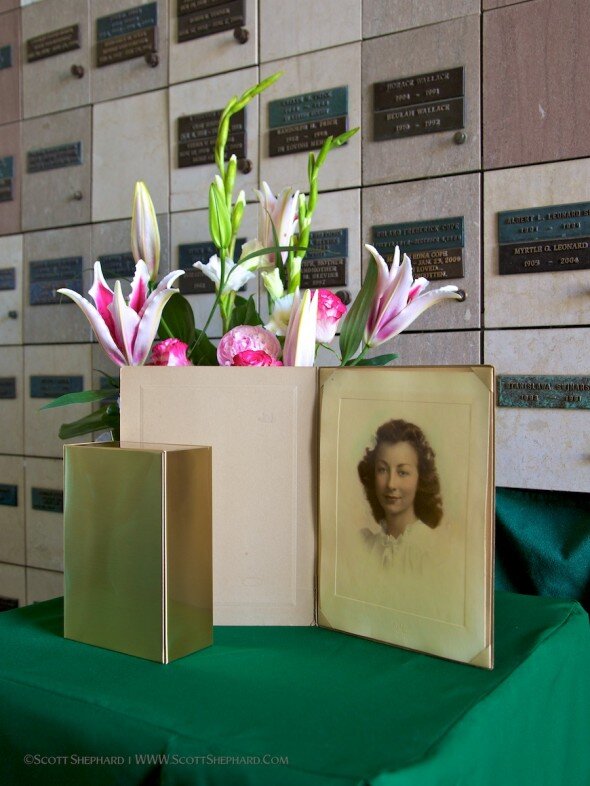 While going through my Aunt Betty's photo collection, we came across this portrait of her sister (my aunt) Phyllis. I was struck by the beautiful, Rembrandt lighting. I also like the sepia tone of the print. I remember reading that toning was more about preservation than it was about creating an effect. Of course, it would be decades before color film would be introduced when this photo was taken - the early 1920s.Three other things strike me about this photo. First, the aspect ratio is very odd by today's standards. I have cropped this photo a bit and the original was narrow and tall. Why? I don't know. The second thing that I noticed was that Phyllis' right hand is blurred, no doubt because the photographer had to use a slow shutter speed. Old films were slow and required several second exposures. Finally, I am impressed with the perfect condition of this photo. It was properly processed and then properly preserved.Who will be looking at our photos 90 years from now and writing commentary?In my continuing effort to get more people to see my students' photos, here's another great portrait, done by Kendra Gortmaker. Her subjects are her daughter and husband and she used availably light to make this photo. Here's Kendra's web site.
While going through my Aunt Betty's photo collection, we came across this portrait of her sister (my aunt) Phyllis. I was struck by the beautiful, Rembrandt lighting. I also like the sepia tone of the print. I remember reading that toning was more about preservation than it was about creating an effect. Of course, it would be decades before color film would be introduced when this photo was taken - the early 1920s.Three other things strike me about this photo. First, the aspect ratio is very odd by today's standards. I have cropped this photo a bit and the original was narrow and tall. Why? I don't know. The second thing that I noticed was that Phyllis' right hand is blurred, no doubt because the photographer had to use a slow shutter speed. Old films were slow and required several second exposures. Finally, I am impressed with the perfect condition of this photo. It was properly processed and then properly preserved.Who will be looking at our photos 90 years from now and writing commentary?In my continuing effort to get more people to see my students' photos, here's another great portrait, done by Kendra Gortmaker. Her subjects are her daughter and husband and she used availably light to make this photo. Here's Kendra's web site.
Lil Ann
 This is an informal portrait I took of Ann, who was a friend of my aunt Betty. Ann is 90 years old but looks, sounds and acts like she is at least 20 year's younger. You've got to love Ann. And her red Ford with vanity plates.And this photo was taken by LATI Photo/Media second year student Ashley McCormick. It was taken in one of the many famous New Orleans cemeteries. Here's Ashley's web site.
This is an informal portrait I took of Ann, who was a friend of my aunt Betty. Ann is 90 years old but looks, sounds and acts like she is at least 20 year's younger. You've got to love Ann. And her red Ford with vanity plates.And this photo was taken by LATI Photo/Media second year student Ashley McCormick. It was taken in one of the many famous New Orleans cemeteries. Here's Ashley's web site.
Pacific View
 This post has more personal meaning than it does photographic value. It is a quick shot I took of the display for my Aunt Betty at her recent memorial service in California. The cemetery is called Pacific View and though the Pacific ocean isn't visible in this photo, it is visible from Betty and Cliff's niche.Pacific view has conventional graves, as John Waynes' proves. But this cemetery has several buildings with walls of niches. We don't have anything like this in South Dakota and I'm not sure why. We have more space? Is is cultural? I've not read it but I just put The American Way of Death, Revisited on my reading list. Maybe I would get some answers there. . . .
This post has more personal meaning than it does photographic value. It is a quick shot I took of the display for my Aunt Betty at her recent memorial service in California. The cemetery is called Pacific View and though the Pacific ocean isn't visible in this photo, it is visible from Betty and Cliff's niche.Pacific view has conventional graves, as John Waynes' proves. But this cemetery has several buildings with walls of niches. We don't have anything like this in South Dakota and I'm not sure why. We have more space? Is is cultural? I've not read it but I just put The American Way of Death, Revisited on my reading list. Maybe I would get some answers there. . . .
Winging It Again
 Because my wife is a Delta Silver Elite member, we sometimes get exit row seats, which are often located over a wing. And because we have been booking our tickets "late in the game," I often get a window seat, rather than my preferred aisle seat. And because our plane left Minneapolis an hour late, I saw the sunset just off of the tip of the starboard wing.And because of all of this, you are seeing a rather mundane wing shot. But in truth I am posting this today so I really have the opportunity to feature another great student photo, this time of a window in an old house. The photographer was Danine Jacobson, the photo is an HDR manipulation and it won a prize in a South Dakota student photography contest. Here's Danine's web site. And here's another view of this same window.
Because my wife is a Delta Silver Elite member, we sometimes get exit row seats, which are often located over a wing. And because we have been booking our tickets "late in the game," I often get a window seat, rather than my preferred aisle seat. And because our plane left Minneapolis an hour late, I saw the sunset just off of the tip of the starboard wing.And because of all of this, you are seeing a rather mundane wing shot. But in truth I am posting this today so I really have the opportunity to feature another great student photo, this time of a window in an old house. The photographer was Danine Jacobson, the photo is an HDR manipulation and it won a prize in a South Dakota student photography contest. Here's Danine's web site. And here's another view of this same window.
At the Zoo
Famous People
 It's not everyday you get to photograph the governor of South Dakota - or pose in a photo of the governor, for that matter.Sara F and McKenzie K, students in the Lake Area Technical Institute Photo/Media program, were covering the annual Governor's Scholarship Luncheon. At the end of the event, I asked for a quick photo and they all graciously cooperated. The subjects are good in this photo, though it violates some rules. Don't tell anyone, but I did some digital manipulation and journalistic photos shouldn't do that. The background could have been better. :-( Why do I make rookie mistakes? Because I am a learner, too. . . .Canon 5DII 1/60s f/4.0 ISO800 66mm Scott ShephardFor the next several days, I will be featuring a photo taken by one of my 2nd year Photo/Media students at Lake Area Technical Institute. Today's photo was taken by McKenzie Kamrath, of Canby, MN. McKenzie's web site.
It's not everyday you get to photograph the governor of South Dakota - or pose in a photo of the governor, for that matter.Sara F and McKenzie K, students in the Lake Area Technical Institute Photo/Media program, were covering the annual Governor's Scholarship Luncheon. At the end of the event, I asked for a quick photo and they all graciously cooperated. The subjects are good in this photo, though it violates some rules. Don't tell anyone, but I did some digital manipulation and journalistic photos shouldn't do that. The background could have been better. :-( Why do I make rookie mistakes? Because I am a learner, too. . . .Canon 5DII 1/60s f/4.0 ISO800 66mm Scott ShephardFor the next several days, I will be featuring a photo taken by one of my 2nd year Photo/Media students at Lake Area Technical Institute. Today's photo was taken by McKenzie Kamrath, of Canby, MN. McKenzie's web site.
04-24-12 A Good Crowd On Hand
 On April 23, 2012, Lake Area Technical Institute in Watertown South Dakota, dedicated the glorious new student center, aka Phase 3. There were speeches, fireworks, and treats. And there was also a very good crowd, as you can see in this photo.Giving an idea of scale in a big space can be difficult. My thinking when I took this photo was that if I could frame the crowd on the first level with people standing at the railing of the second level, you would get a better sense of space. Plus, it's not bad to find elements within a scene that provide framework within a photo.Canon 5DII 1/80s f/4.0 ISO800 24mm ©Scott Shephard
On April 23, 2012, Lake Area Technical Institute in Watertown South Dakota, dedicated the glorious new student center, aka Phase 3. There were speeches, fireworks, and treats. And there was also a very good crowd, as you can see in this photo.Giving an idea of scale in a big space can be difficult. My thinking when I took this photo was that if I could frame the crowd on the first level with people standing at the railing of the second level, you would get a better sense of space. Plus, it's not bad to find elements within a scene that provide framework within a photo.Canon 5DII 1/80s f/4.0 ISO800 24mm ©Scott Shephard
Spring Blossom
 Flowering crab apple trees are something we normally see at a distance and appreciate for the few days that they flower. This morning I took my camera a moved in for a closer view. And the quantity and coloration of these little flowers was truly amazing. I took about 120 photo, though most are very similar.About half way through my shoot, I realized that I was smiling and that I had been for most of the time I was taking photographs. I guess it's good to find simple joy in the beautiful things that Nature gives us.
Flowering crab apple trees are something we normally see at a distance and appreciate for the few days that they flower. This morning I took my camera a moved in for a closer view. And the quantity and coloration of these little flowers was truly amazing. I took about 120 photo, though most are very similar.About half way through my shoot, I realized that I was smiling and that I had been for most of the time I was taking photographs. I guess it's good to find simple joy in the beautiful things that Nature gives us.
Watertown's Newest Photo Gallery
 We are putting the finishing touches on the new student Photo/Media Program photo gallery at Lake Area Technical Institute. This is one of two walls of student photos. Tomorrow, the Governor of South Dakota comes to LATI to help dedicate the new wing of our campus and we are hoping he comes to admire the student photos.If you live in Watertown, you might consider coming to the LATI open house, which starts at 2:00 and ends at 6.
We are putting the finishing touches on the new student Photo/Media Program photo gallery at Lake Area Technical Institute. This is one of two walls of student photos. Tomorrow, the Governor of South Dakota comes to LATI to help dedicate the new wing of our campus and we are hoping he comes to admire the student photos.If you live in Watertown, you might consider coming to the LATI open house, which starts at 2:00 and ends at 6.
Yes, I Am . . .
Transformational Technology
 This is a photo I took of Ethan working on an iPad during his sister, Evie's, baptism gala and there is much that I could say about the photo or about the event. But I want to talk about difference between adults and children when it comes to iPads.Give an iPad to a child (or an adult who has never touched a "regular" computer) and they adapt very quickly. It turns out that the fingers of the hand are pretty facile and intuitive tools. Even a caveman would probably agree with that.But give an iPad to an adult with years of normal computer use and they will say, "Can I plug in a mouse?" or "How do I hook up a keyboard?" Quite honestly, keyboards and mice aren't the least bit "natural" or intuitive. In fact, the QWERTY keyboard layout was invented in the 1878 and designed in such a way that keys wouldn't jam together if a person typed too quickly.Keyboards, mice, desktops and folders were integrated into desktop computers because computer engineers wanted to make the transition from a traditional office to an office centered on computer workstations less threatening. Microsoft even threw in Paper Clip Man in MS Word to give a human face to the New Machine.The iPad, and other tools like it, are changing all of that. In fact, I've read that Jobs wouldn't allow USB ports in iPads because he didn't want it to be driven by peripherals. He wanted to push "touch" and the human hand as the most logical peripherals. Beyond that, you don't have to worry about saving documents. Computer folders are very 20th century.I think the iPad is the prototype for the next generation of computers - no mice, no hard drives, no DVD drives, no folders and no desktop. And certainly no Paper Clip Man. A keyboard? No doubt there will be one for people like me, who at least in this way, are stuck in the 19th century.But now that I think of it, Apple has given us another glimpse of the future of computer input: Siri, which is voice recognition with a friendly attitude. But beyond that, it is intelligent voice recognition - Siri gets to know us and knows what we mean even when we don't say it. Wow!
This is a photo I took of Ethan working on an iPad during his sister, Evie's, baptism gala and there is much that I could say about the photo or about the event. But I want to talk about difference between adults and children when it comes to iPads.Give an iPad to a child (or an adult who has never touched a "regular" computer) and they adapt very quickly. It turns out that the fingers of the hand are pretty facile and intuitive tools. Even a caveman would probably agree with that.But give an iPad to an adult with years of normal computer use and they will say, "Can I plug in a mouse?" or "How do I hook up a keyboard?" Quite honestly, keyboards and mice aren't the least bit "natural" or intuitive. In fact, the QWERTY keyboard layout was invented in the 1878 and designed in such a way that keys wouldn't jam together if a person typed too quickly.Keyboards, mice, desktops and folders were integrated into desktop computers because computer engineers wanted to make the transition from a traditional office to an office centered on computer workstations less threatening. Microsoft even threw in Paper Clip Man in MS Word to give a human face to the New Machine.The iPad, and other tools like it, are changing all of that. In fact, I've read that Jobs wouldn't allow USB ports in iPads because he didn't want it to be driven by peripherals. He wanted to push "touch" and the human hand as the most logical peripherals. Beyond that, you don't have to worry about saving documents. Computer folders are very 20th century.I think the iPad is the prototype for the next generation of computers - no mice, no hard drives, no DVD drives, no folders and no desktop. And certainly no Paper Clip Man. A keyboard? No doubt there will be one for people like me, who at least in this way, are stuck in the 19th century.But now that I think of it, Apple has given us another glimpse of the future of computer input: Siri, which is voice recognition with a friendly attitude. But beyond that, it is intelligent voice recognition - Siri gets to know us and knows what we mean even when we don't say it. Wow!
04-16-12 Take A Closer Look
 While I was waiting for a few of my students to take photographs of the amazing Cathedral of St. Paul, I stepped outside and took a few shots of the exterior. I had my 70-200 telephoto with me and so I focused on details.It occurs to me that what you see in this photo and how you see it are totally dependent on the photographer. And that's an interesting power to have. . .
While I was waiting for a few of my students to take photographs of the amazing Cathedral of St. Paul, I stepped outside and took a few shots of the exterior. I had my 70-200 telephoto with me and so I focused on details.It occurs to me that what you see in this photo and how you see it are totally dependent on the photographer. And that's an interesting power to have. . .


